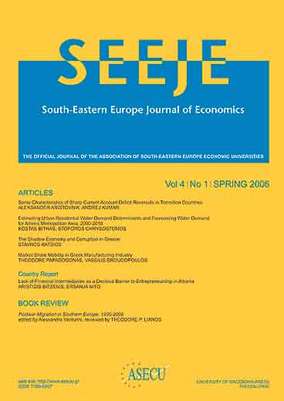Using gravity models for the effective determination of socioeconomic locality : local labour markets in Central Macedonia
Part of : SEEJE ; Vol.11, No.2, 2013, pages 177-185
Issue:
Pages:
177-185
Abstract:
The discussion about the effectiveness of active policy measures that consider spatial socioeconomic aspects has become especially important in light of recent socio-economic developments. The paper presents an alternative methodology for the determination of spatial boundaries for any socioeconomic locality, based on the gravity models tradition. We apply the described methodology to the Region of Central Macedonia and show that there are significant discontinuities between administrative spatial segregation on the one hand and socioeconomic on the other. The latter provides evidence for the inappropriateness of simply following the administrative boundaries and reveals the usefulness of our proposal.
Subject (LC):
Keywords:
spatial socioeconomic policy, local labour market, gravity model
Notes:
Περιέχει πίνακες και βιβλιογραφία, The paper was presented at the 3rd International Summer School of ASECU-Youth in Kotor, Montenegro, 2012., JEL Classification: R12, R58, J68
References (1):
- Ballas D., Clarke G.P. (2000): GIS and microsimulation for local labour market policy analysis,Computers, Environment and Urban Systems, 24, pp. 305-330.Casado-Diaz J.M. (2000): Local Labour Markets in Spain: A case study. Taylor and Francis Journals,Vol. 34 (9), pp. 843-856.Cieślik Andrzej (2009): Bilateral trade volumes, the gravity equation and factor proportions, Journalof International Trade & Economic Development, Taylor and Francis Journals, 18(1), pp. 37-59.Converse, P. D. (1949): New Laws of Retail Gravitation. Journal of Marketing, Volume 14, January,pp. 379-384.Deardorff A.V. (1998): Determinants of bilateral trade: Does gravity work in a neoclassical world?in: Frankel J.A. (eds), The regionalization of the world economy. Chicago: The University ofChicago Press.Duncan Bowie (2010): People, Planning and Homes in a World. RoutledgeLeamer Edward Ε., Levinsohn James (1995): International Trade Theory, the Evidence. In Grossmanand Rogoff (eds), Handbook of International Economics 3. North-Holland.Rose A. (2000): One money, one market: the effect of common currencies on trade. EconomicPolicy, 30, pp. 9-45.Zarotiadis G., Stamboulis M. (2011): Using Gravity Models in Regional Socioeconomic Policy:pilot applications in active labour market policies, Portuguese Journal of Quantitative Methods,Vol 1-II, pp. 63-73.




